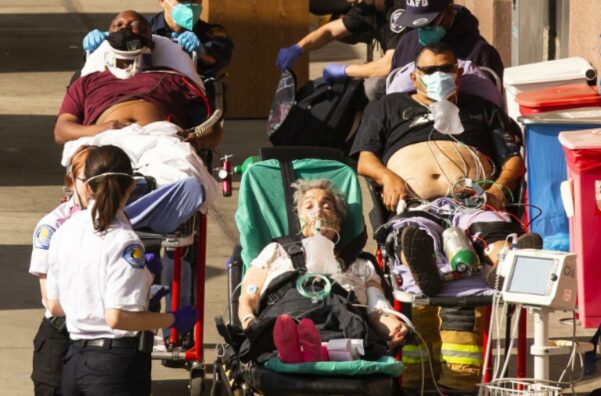According to CNN, the number of coronavirus infections in Los Angeles is rising sharply.
The epidemic is spreading rapidly among family members.
On average, one person is infected in six seconds and one person dies from COVID-19 every eight minutes.
Los Angeles is one of the most populous areas in the United States, where more than a quarter of Californians live.
LA County has seen more than 11,000 deaths since the start of the coronavirus pandemic, with more than 5,000 deaths in the last two months, according to the latest data from the Los Angeles Department of Public Health.
Los Angeles County has seen a 941% increase in infections since November 1 last year, and the test positive rate has jumped from 3.8% to 21.8% in the past two months.
The hospital’s oxygen cylinder is exhausted, and the intensive care unit is full.
ABC recently reported that the Los Angeles health care system is experiencing an endless nightmare due to the worsening epidemic.
The emergency room of the local hospital is overcrowded, and patients whose lives are not in danger for the time being need to wait 12 to 18 hours before seeing a doctor.
The Situation Of Pandemic in Los Angeles
The hospitalization rate is 10 times higher than two months ago, and the intensive care unit is full and difficult to find one bed. The most terrible thing is that there is a serious shortage of oxygen cylinders now, and some hospitals have run out of oxygen cylinders. .
One of the most important care for COVID-19 patients is to provide them with enough oxygen. If the patient’s blood oxygen saturation is less than 90%, it will cause problems.
At present, the supply of oxygen cylinders in Los Angeles hospitals is in short supply. Ambulance personnel are told to save oxygen consumption and ration oxygen to patients, so as to maintain 90% or slightly more of patients’ blood oxygen saturation.
According to the regulations of the health department, a nurse used to be responsible for only one or two critically ill patients, but now needs to take care of six or seven patients at the same time due to the shortage of medical staff.
Some hospitals have announced the launch of “crisis standards” that allow medical staff to appropriately lower standards of care. Local health departments have paid a lot of money to hire medical staff from other states to rescue, but the states are already overwhelmed.
“I’ve been in the hospital for over thirty years and have never seen a scene like this.” Local medical staff said, “It’s terrible.
The hospital is like a wartime state now.”
Don’t send patients with “life-threatening” to hospitals.
The surge in COVID-19 cases and a critical shortage of medical resources have led to a significant change in the way the Los Angeles area handles emergencies.
People should not dial 911 unless it is absolutely urgent.
“If people call 911 emergency medical services as soon as they have a situation, people who really need help will be affected,” explained Mark Eckstein, the Los Angeles Fire Department’s Emergency Medical Services commander.
Change 2: If the on-site rescue fails, ambulances should not send patients to the hospital.
If the patient has stopped beating his heart at the scene, the survival rate of sending it to the hospital for re-reparation is also very low, because of the shortage of medical resources, the hospital has to focus on patients with higher survival opportunities.
In the past few weeks, ambulances have typically had to wait hours outside the hospital to transfer patients to the emergency room, according to Ekstein, “There was one hospital that had 19 ambulances waiting to transfer emergency patients at the same time during Christmas week.”
In the face of such a serious situation, doctors had to rescue patients in ambulances.
Hospitals add temporary beds in various available corners such as corridors and parking lots to receive patients sent by ambulances so that ambulances can be put into work.
In addition, due to the surge in deaths, funeral services at Los Angeles cemetery have been scheduled for April this year.
Local media wrote that in a country with an advanced health care system, the United States, is now facing the dilemma of no place to die.
On January 9th, local time, Dr. Anish Mahajan, chief physician of UCLA Medical Center, said that the current stage of the epidemic in Southern California is worrying, but because the peak of the epidemic caused by holiday travel has not yet arrived, there may be a further surge in cases in the next seven to 10 days, causing the collapse of the local health care system. Fate.
“The biggest advice we give people right now is to stay healthy so you don’t need urgent care and don’t need to go to the hospital for treatment,” said Dr. Jeffrey Goodlow, president of the American College of Emergency Physicians. He added: “Prevention is more important than ever.”



